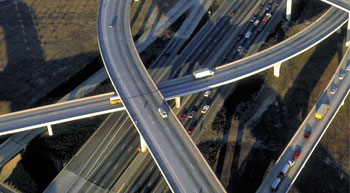The Centre is pulling out all the stops to rejuvenate the country’s roads, railways and airports with holistic and well-laid out programmes.
Speaking recently at the industry lobby group FICCI’s annual general meeting in New Delhi, Nitin Jayram Gadkari, Union Minister for Road Transport and Highways and Shipping, said the government has proposed a multimodal transport hub plan, which seeks to integrate major modes of transport such as roads, railways, ports and air. ‘We have come across the new concept, which has emerged as the modern concept at the global level. We had constituted a consultant to study if a multimodal system can be built in Nagpur and Varanasi. The consultant has submitted its report, which we are studying now,’ informed Gadkari.
The government has also proposed construction of 12 express highways across the country for the first time. Two new by-passes costing Rs 150 billion each are also being built to decongest the city-state of Delhi. The Ministry of Road Transport and Highways would be utilising the debris from Delhi’s Ghazipur dumping ground for the construction of the highway between Delhi and Meerut.
The Ministry is targeting to implement Rs 25,000 million worth of projects in five years. Of these, Rs 15,000 million will be in the road sector and Rs 10,000 million in the shipping sector.
The year 2016 saw a lot more activity in the roads and highways development compared to the past few years. ‘On the development side, the Hybrid Annuity Model (HAM) has taken off. Till October 2016, 24 projects totalling nearly 1,300 kilometres and a project cost of over Rs 140 billion have been awarded. The banks are looking at HAM projects favourably and projects are being financed at competitive interest rates of 10 to 10.5 per cent. On the secondary transactions, the market is seeing new buyers emerge in addition to the existing investors, resulting in a lot of traction in the market,’ observes Srishti Ahuja, Director, Transaction Advisory Services, Ernst & Young.
Another interesting trend in the sector is the emergence of regional players. Consequently, several mid-sized highway players have become dominant industry players, with a few of them also eyeing the public markets.
In 2017, the biggest event to watch out in the sector shall be the rollout of the toll-operate-transfer (TOT) bids. Says Ahuja, ‘Large institutional investors are closely monitoring the process and it will be interesting to see how the National Highways Authority of India (NHAI) addresses some of the requirements that the interested participants have presented. The TOT bid projects will be a good deployment opportunity for low risk, low cost capital investors, and at the same time, it will bring in best practices on the operation and maintenance as well as traffic management side. At the same time, with NHAI having laid out a stiff target of 25,000 kilometres for 2017, the developers will also have several opportunities.’
Railways
Speaking at the same event, Suresh Prabhakar Prabhu, Union Minister of Railways, blamed the sluggish growth of infrastructure as the main hindrance in the growth of the railway sector in the country.
‘Indian Railways needs structural changes and investment. It is suffering only because of lack of investments,’ said Prabhu.
‘Traditionally, Indian Railways relies on freight and fare for revenue, but that is not going to work because the cost of operations has gone up significantly. The biggest burden of the Pay Commission is on the railways, the largest employer in the country,’ he added.
While public investment remains a key source of investment, the railways has opened up various sectors for private participation, including manufacturing of diesel and electric locomotives, railway station redevelopment and integrated multimodal transport system.
The Railways Ministry is simultaneously undertaking structural changes in its management to achieve faster decision making and enhance operational accountability.
Emphasis is also being laid on expanding revenue streams and monetisation of assets. A separate Non-Fare Revenue Directorate was created in early 2016 to find ways for generating substantial revenue from sources other than passenger fares and freight. The government is currently working on various equity models including joint ventures with state governments, public-private partnership (PPP) and private participation to mobilise resources for investment in railways and also remove impediments such as land acquisition and law & order to expedite infrastructure development.
Airports
According to industry observers, the Indian aviation sector has dramatic potential for growth with 150 million passenger trips a year as compared to China with 450 million passenger trips and the US at 800 million passenger trips a year. The total revenue of Indian carriers is Rs 1,400 billion and is growing at a Compounded Annual Growth Rate (CAGR) of 20 per cent. As of date, nearly 90 million passengers travel domestically and 50 million internationally.
‘The aviation sector is the sunrise sector of growth and going through profound changes,’ observed Jayant Sinha, Minister of State for Civil Aviation, at the FICCI event.
For its part, the government has identified three priority areas for itself. One, a better, delightful and digital experience through AirSewa, which serves as an integrated collaborative platform. Adopting the Japanese Kaizen principle, the Civil Aviation Ministry will undertake continuous improvement in areas such as airport facilities, immigration and customer services. Two, under the Regional Connectivity Scheme (RCS), the government is looking at doubling of air connectivity from 75 to 150 airports in the country.
Plans are also afoot to build airport capacity by expanding existing terminals, building new terminals and developing greenfield airports. According to the government’s estimates, investment of up to Rs 3,000 billion is required for developing new airports, excluding the land acquisition cost. The regulatory framework for the aviation sector is also being tweaked to make it an attractive asset class.
As part of the government’s commitment to the safety and security of airline passengers, going forward, the unified command of the Central Industrial Security Force (CISF) will be launched throughout the aviation system.
– Manish Pant



Leave a Reply
You must be logged in to post a comment.